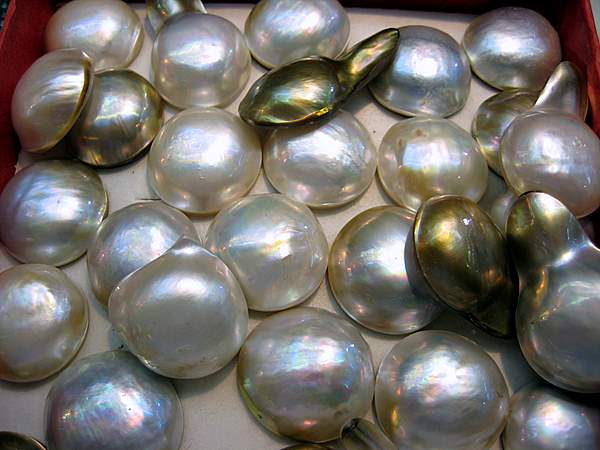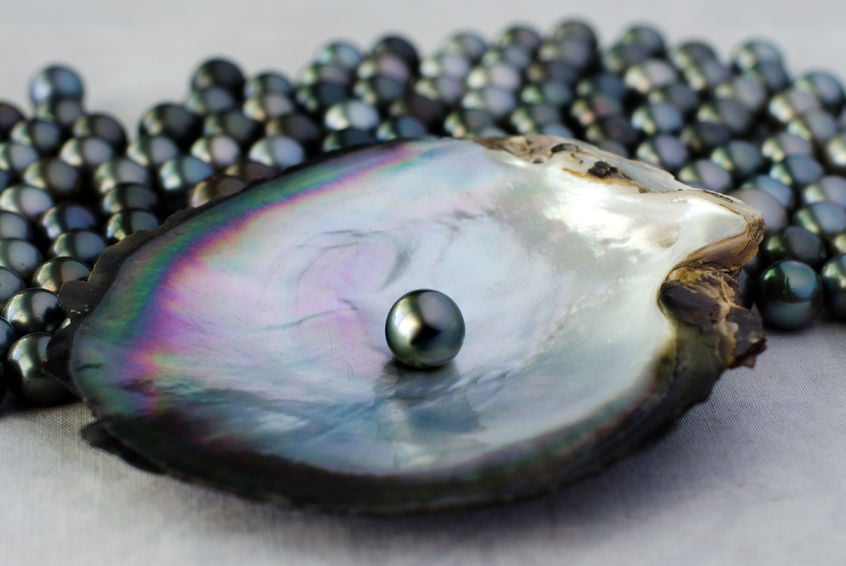What Is A Blister Pearl? How Are They Different?
A regular pearl is known as a cyst pearl. It is formed in the fleshy part of mollusks in a pearl sac. At the time of removal, it is harvested out of this sac.
But a blister pearl is one that breaks out of the pearl sac before maturity and finds its way in between the mantle and shell. The pearl secretes more layers of calcium carbonate and the pearl fuses with the shell over time. This pearl needs to be cut out of the shell of the oyster.
Although they are not as popular as cyst pearls, they are beautiful and come in a varying range of hues. Some blister pearls feature an extraordinary golden swirl.
What Is A Blister Pearl And How They Are Used In Jewelry?
As we mentioned, blister pearls are fused to the shell of a mollusk and are harvested by cutting them out of a shell. Just like natural pearls, blister pearls form after a foreign object enters the body of the mollusk.
The primary difference is that, while a regular pearl forms in the fleshy parts, a blister pearl protrudes from the shell’s inner lining. Instead of being round, they have a flattened, hemispherical shape that makes for some unique jewelry.
After a blister pearl is taken out by cutting and grinding it out of the shell, it is then prepared to be used in jewelry making. Starting from pinkish hues to cooler blue tones, blister pearls can even feature a rainbow-like luster.
The center of a blister pearl is removed and instead filled with resin. The flattened back that is cut off the shell is plastered with nacre or Mother of Pearl. Now that they are prepared for jewelry placement, they are technically called Mabe pearls.
How To Clean Pearls With Mild Stains?
To clean pearls that are appearing stained, you need some lukewarm water and a few drops of any mild dish soap you can get your hands on. After dipping a soft cleaning cloth in this soap-water solution, use that cloth to gently wipe your pearls. If you are thinking you will do one better and dip the entire necklace in the solution, then let me stop you right there. Doing this will weaken the silk thread that your pearls are strung on.
Make sure to let the pearls dry before storing them. It is also a good idea to wipe your pearls with a soft cloth every time you are done wearing them. To prevent staining, wear pearls after you are done with makeup and hair. They should be the last accessories you put on and the first ones you take off.
What Shells Have The Mother of Pearl?
The mother of Pearl is present in certain mollusks. Marine oysters as well as freshwater mussels have this substance on the lining of their shells. The Mother of Pearl is also termed nacre and it has an iridescent glow on it that makes pearls so beautiful.
This glow is what helps identify which mollusks have nacre on their shells and which don’t. Pinctada margaritifera and Pinctada maxima are common species of oysters that have nacre and produce pearls.
Where Do Mabe Pearls Come From?

Mabe pearls are cultivated in Australia and the South Pacific. Black-lipped and silver-lipped oysters produce these blister or mabe pearls. To culture them, Half of a nucleus is positioned on the shell of the oyster instead of the tissue. Just as it happens in nature, after implantation, the oyster keeps secreting layers of nacre at that spot.
It takes about 9-12 months for each of the oysters to produce mature blister pearls. You can expect anywhere between 4-6 pearls from one cultured oyster.
What Type of Pearl Is The Most Valuable?

South Sea Pearls are generally more valuable than other pearls in today’s market. They tend to be larger in size and radiate in many different hues. Out of all the varieties of South Sea Pearls that are out there, golden ones are the most expensive and rare.
When it comes to cultured pearls, these beautiful gemstones have the thickest nacre. They can grow as large as 20 mm in diameter. Out of all the pearls cultured in South Sea oysters, only 30% come out with a round shape or a near-round one. Drop-shaped and irregularly-shaped South Sea Pearls are also popular. They are used to create some of the best high-end pearl jewelry.
Read also: How Much Is A Black Pearl Worth
What’s The Rarest Color of Pearl?
The rarest color of pearls that occurs in nature is blue. They are beautiful and come with a variety of overtones such as green, teal, blue-green, violet, rose, etc. Interestingly, blue pearls are seen in virtually all pearl types but for you to come across a blue Tahitian, South Sea, Freshwater, or Akoya pearl is a rare possibility.
This color is gaining popularity and its value is also higher than ever. The blue color is rare because it is actually only a result of a metabolic disorder in the Mollusk. A metabolic disorder may not sound as romantic, but these pearls are exquisite and depending on the type of pearl can be as big as 16 mm or more.
Are Older Pearls Worth More?
Older pearls aren’t necessarily worth more. In recent times, pearl culturing techniques have advanced so much that your grandma’s pearls are likely to be worse in quality.
For older pearls to be worth more, they have to have some historical importance. If they were worn by someone famous and iconic, then yes, they are most likely to be worth more. For example, Jackie Kennedy’s beloved glass pearls were auctioned off for over US$200,000. Today, a similar sting of pearls will only cost $100.
That being said, wild pearls are certainly seeing an increase in value because of how rare they are these days due to global warming and water pollution. But a regular strands of old wild pearls aren’t the ones that are seeing this price shift, only unique and interesting pieces that are a combination of many gems and metals have so far increased in value.
Related posts:
Saltwater VS Freshwater Pearl
How To Wear A Pearl Necklace Casually
